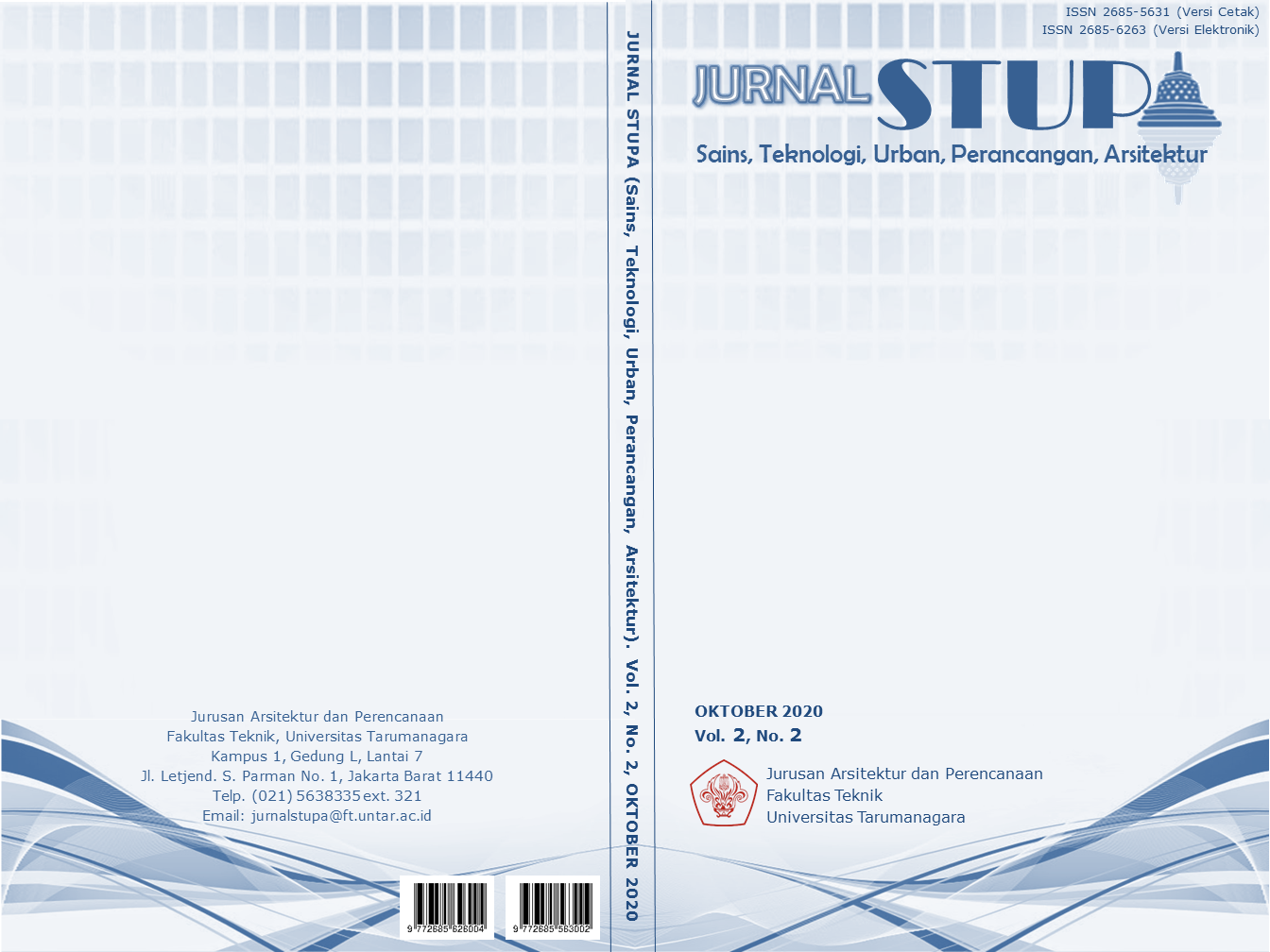RUANG PEREDA STRESS DI MAPHAR
Main Article Content
Abstract
individualistic characteristics, and are more sensitive to their personal space. This happens because of their lack of need for other people around them. All are available on a gadget or smartphone, they can send messages, buy goods, find information, with more easily and practically. The state of the city has also become functionalist, where people only have functional activities without thinking about elements such as interacting or socializing. In fact the workers go to work and will go straight home, then spend time watching television or just relaxing at home to relieve stress. These problems occur in the metropolitan city of Jakarta and are becoming increasingly complex, due to unequal social welfare that occurs in the community, as happened in Maphar Village, Taman Sari, West Jakarta. This area was indeed from the Dutch era dominated by people of Chinese descent who worked as traders. In this area the conditions and situation of the house were so tight that there was no room for reforestation or a place to relax. This is where the task of an architect which can provide an activity space for the community in the form of a third space as a solution in healing people with stress disorders. With the third room that is presented in the design of a building, by providing programs or facilities that are appropriate, and appropriate to the problem of stress by creating a stress relief room in the form of an outdoor classroom aimed at providing education and workshops for children and adults, Studio training, and the creative stage as a forum for the community to channel their talents and interests in the arts, mediatech library as a place for children to get positive space for learning, and other supporting programs.
Keywords: interaction; stress; third place; tight
Abstrak
Pesatnya perkembangan teknologi, masyarakat yang hidup di zaman modern ini cenderung memiliki sifat yang individualis, dan lebih sensitif terhadap personal space-nya. Hal ini terjadi karena rasa ketidakbutuhan mereka terhadap orang lain yang ada di sekitarnya. Semua sudah tersedia di gadget atau smartphone, mereka bisa mengirim pesan, membeli barang, mencari informasi, dan lainnya dengan mudah dan praktis. Keadaan kota juga menjadi fungsionalis, dimana masyarakat hanya beraktivitas secara fungsional tanpa memikirkan elemen seperti berinteraksi atau bersosialisasi. Kenyataannya para pekerja pergi bekerja dan akan langsung pulang ke rumah, kemudian menghabiskan waktu dengan menonton televisi atau hanya bersantai di rumah untuk menghilangkan stres. Permasalahan-permasalahan tersebut terjadi di kota metropolitan Jakarta dan menjadi semakin kompleks, karena tidak meratanya kesejahteraan sosial yang terjadi di masyarakat, seperti yang terjadi di Kelurahan Maphar, Taman Sari, Jakarta Barat ini. Kawasan ini memang dari zaman Belanda didominasi oleh orang-orang keturunan Tionghoa yang bekerja sebagai pedagang. Di daerah ini kondisi dan situasi rumahnya pun sangat rapat sampai tidak ada ruang untuk penghijauan atau tempat bersantai. Disinilah tugas seorang arsitek yang mana dapat memberikan ruang aktivitas untuk masyarakat berupa ruang ketiga sebagai solusi dalam penyembuhan terhadap masyarakat dengan gangguan stres. Dengan ruang ketiga yang dihadirkan dalam rancangan sebuah bangunan, dengan memberikan program atau fasilitas yang sesuai, dan tepat terhadap masalah stres dengan menciptakan sebuah ruang pereda stres berupa outdoor classroom yang bertujuan memberi edukasi dan workshop bagi anak-anak maupun orang dewasa, Pelatihan sanggar, dan panggung kreasi sebagai wadah masyarakat menyalurkan bakat dan minat di bidang seni, mediatech library sebagai tempat anak-anak mendapat ruang positif untuk belajar, dan program pendukung lainnya.
Article Details
References
Olgray, V. (1963). Design with Climate: Bioclimatic Approach to Architectural Regionalism. 1st ed. Princeton, N.J.: Princeton University Press.
Oldenburg, R. (1989). The Great Good Place. Cambridge Centre, USA: Paragon House.
Hardianto, F., Nugroho. (2009). Analisis Faktor-Faktor Yang Mempengaruhi Tingkat Kriminalitas Di Indonesia Dari Pendekatan Ekonomi.
https://www.brikbase.org/sites/default/files/Architectural%20Healing%20Environments.pdf
Montgomerry, C. (2013). Happy City. Canada: Farrar
Zaenuddin (2012). 212 Asal – Usul Djakarta Tempo Doeloe. Jakarta: Ufuk Press


